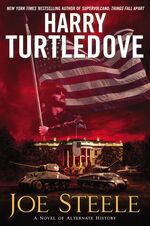
Tarawa is an atoll and the capital of the Republic of Kiribati, in the central Pacific Ocean. It comprises North Tarawa, which has much in common with other, more remote islands of the Gilberts group; and South Tarawa, which is home to 50,182 as of 2010 - half of the country's total population. The atoll is best known by outsiders as the site of the Battle of Tarawa during World War II.
During World War II, Tarawa was occupied by the Japanese, and beginning on November 20, 1943 it was the scene of the bloody Battle of Tarawa. On that day United States Marines landed on Tarawa and suffered heavy losses from Japanese soldiers occupying entrenched positions on the atoll. The Marines secured the island after 76 hours of intense fighting with around 6,000 dead in total from both sides.
Tarawa in Joe Steele[]
Mike Sullivan's punishment brigade was finally deployed to take the island of Tarawa from the Japanese. The US Navy first shelled the the Japanese gun emplacements on the southern part of the island and sent out naval fighter-bombers to provide air support. At 0900, punishment brigade troops and US marines descended from troopships onto amphibious tractors and set out towards the beach. At this point, the Japanese began firing lighter guns which had been kept under wraps. A few amtracs were hit but most crawled over a reef and onto the beach. When the armored fronts were dropped, the charging troops were subject to machine gun fire.
Officers encouraged the men to get off the beaches and into the jungle as quickly as possible since they would be less exposed there. The preparatory bombardment hadn't cleared all enemy bunkers and dugouts so clearing them was a slow, bloody action. In addition, the Japanese had had plenty of time to situate each emplacement such that they were protected by other ones further back. Not only did the Japanese fight hard, they refused to surrender and so had to be killed or wounded in place.
By nightfall, the landing forces had gotten off the beach and taken parts of the jungle. Things quietened down so the troops had some rest. The next morning, the fighting picked up but more Marines landed further north putting the Japanese into a pincer. It took two more days but the U.S. forces were victorious. Only a couple of dozen seriously wounded Japanese were taken prisoner along with a hundred or so Korean laborers who had surrendered. The U.S. suffered a thousand dead, punishment brigade troops and Marines, but it was a victory. Some of the Marines remained on the island to garrison it while the survivors of the P-brigade were shipped back to the replacement depot on Espiritu Santo to refit and redeploy.[1]
References[]
- ↑ Joe Steele, pgs. 284-287, HC.
| |||||||||||||||||||
